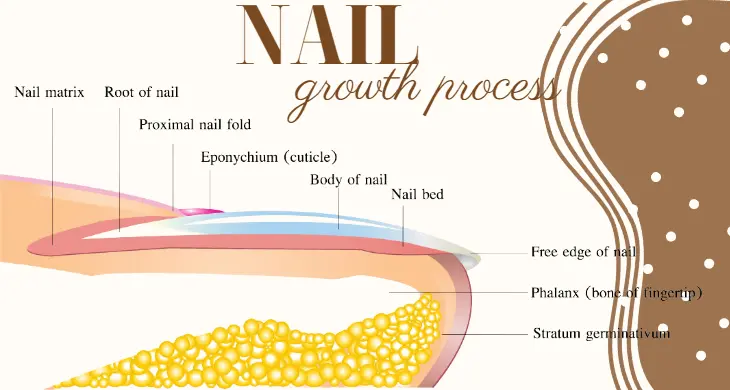The growth of nails follows a cyclical process that involves several stages. Understanding this cycle can help in comprehending how nails grow and how to take care of them effectively. Let’s explore the different phases of the nail growth process:
Anagen Phase (Growth Phase):
The anagen phase is the active growth phase of the nail. During this phase, cells in the matrix (the area at the base of the nail) divide rapidly, and new nail cells are produced. The new cells push the existing cells forward, leading to the elongation of the nail plate.
Catagen Phase (Transition Phase):
The catagen phase is a brief transition phase between the growth and resting phases. It marks the end of active cell division in the matrix and prepares the nail for the next phase.
Telogen Phase (Resting Phase):
The telogen phase is the resting phase of nail growth. In this phase, the nail plate stops growing, and the matrix is inactive. The nail remains at its full length until it is eventually pushed forward by the new growth during the next anagen phase.
Onychodermal Band:
The onychodermal band is the visible area at the base of the nail plate. It contains the most recently formed cells from the matrix and appears as a lighter shade compared to the rest of the nail plate.
The entire nail growth cycle typically takes around three to six months, although the exact duration can vary among individuals. Factors such as age, overall health, hormonal changes, and seasonal variations may influence the rate of nail growth.
It’s important to note that nails grow at different rates on different fingers or toes and even vary individually. Additionally, factors like nutrition, hygiene, and overall nail care can impact the health and growth of the nails.
To promote healthy nail growth, it is recommended to maintain a balanced diet, ensure proper hygiene, avoid excessive use of harsh chemicals, protect the nails from trauma or injury, and provide regular moisturization to prevent dryness and brittleness.
If you have concerns about your nail growth or experience any persistent issues, consulting a healthcare professional or a dermatologist is advisable for a proper evaluation and guidance.
How to Grow Your Nails Faster
- There is no way for accelerating nail growth that has been established by science. However, over time, taking good care of your body by eating healthily and putting the following nail-strengthening techniques into practise can help your nails grow strong and long.
- Keratin, a tough protein, is used to create the various layers that make up fingernails. Your entire health can be determined by the condition of your fingernails.
- Healthy nails should be uniform in colour, firm and smooth without any dents or grooves.
- If your nails are growing more slowly than they should and you’d like them to, there are some at-home remedies and grooming techniques that may be helpful.
Home remedies for growing nails
1.Biotin-
Biotin is a crucial B vitamin that enables the body to transform food into energy. It is also strongly suggested that you take it as a supplement to strengthen your hair and nails.
Numerous research on people indicate that daily biotin supplementation may strengthen nails. A dose of 2.5 milligrammes of biotin taken daily, according to some scientistsTrusted Source, can increase nail strength in as little as a few weeks. Biotin is naturally present in:
- Brewed eggs with brewer’s yeast
- nuts and nut butters, sardines
- whole grains
- other beans and soy
- cauliflower bananas
- mushrooms
2. Nail hardeners –
- Because soft nails are more likely to break, there is a greater requirement for nail regeneration. Experts typically advise using nail hardeners to prevent nails from breaking. These materials are applied to the nails like polish and then removed using nail polish remover.
- In the near term, this aids in nail strengthening and deters breakage. The extended use of nail hardeners, according to specialists, might occasionally make nails weaker and more prone to fracture.
3.Stay away from harmful polishes and glue-on nails-
- Regular use of glue-on artificial nails can weaken actual nails and increase their susceptibility to breaking, according to researchersTrusted Source. Painting your nails with nail polish that has minimal to no hazardous chemicals, such as:
- DBP, also known as toluene formaldehyde,
- Search for formulations made of water that have a toxin-free label. Suncoat and Acquarella are two well-known nontoxic nail paint brands.
4. Maintain proper grooming-
- Regular nail maintenance can also help strengthen your nails, promote growth, and lessen breakage. Some techniques for maintaining healthy nails include:
- keeping your nails dry and clean, which prevents bacteria from growing beneath them, using sharp manicure scissors or clippers to trim your nails straight across, and then using them to round the tips of your nails into a soft curve moisturising your hands and nails with lotion, being sure to rub it into your fingernails, especially at the base where the cuticles are located, and avoiding nail biting or too-short nail cutting.
What leads to weak nails?
Poor health may cause abnormal nail development. Common problems with nail growth include:
- variations in colour
- modifications to the nail’s thickness or shape separation of the nail from the skin around it bleeding swelling or pain
- slowly expanding nails
Slow nail growth due to ageing could also be a sign of illness or nutritional deficits.
Hormones also have a role in nail growth. Younger people often have quicker growing nails than older ones, while men and pregnant women typically experience faster nail development than others. In healthy individuals, fingernail growth averages 3.5 mm per month.According to a dependable source, it is about the thickness of a ballpoint pen cap
How to lengthen the length of your nail beds
- lengthen your nails
let your nails grow out.You’ll have a longer white tip as your nails grow longer, which aids in lengthening your nail bed. Artificial nails can shield your natural nails from breaks and splits if you have trouble developing your own.
- Instead of using a nail scraper, clean your nails with a brush.
By using a nail brush rather than metal nail tools to clean beneath your nails, you can also give the appearance that your nail beds are longer. The nail plate and nail bed may get separated if a sharp tool is used to clean underneath nails.
- Push your cuticles back.
Cuticles can also be pushed back to create the impression of a longer nail bed. When pressing back the cuticles, soak your nails in warm water to soften them first. A few drops of cuticle oil or an essential oil can be added to the water.
A cuticle stick should be used to gently push back your cuticles after soaking your nails for around five minutes.
Your nail beds’ size and shape are determined by what?
The size and shape of nail beds are mostly determined by genetics. Therefore, if your parents had small nail beds, you might as well.
Your nail bed’s size and shape are largely determined by genetics, but there are other factors that can also have an impact. Some of these elements may give the impression that your nail beds are shorter than they really are. They consist of:
- Nail wounds: Following a nail damage, nail beds might occasionally appear shorter. Certain injuries may cause your nail to separate from the nail bed.
When opening a beverage can, you run the risk of hitting your finger or damaging your nail. There will be a longer white section and a shorter pink section when the nail splits from the nail bed close to the tip.
- Biting of nails: Cutting your fingernails too short or biting them might make it appear as though the nail bed is shorter. This is caused by the tip having little or no whiteness.
- Bacterial infections: If you have a nail fungal infection, your nail bed may also appear shorter.
Conclusion
Despite the fact that your nail beds’ size and shape are largely determined by heredity, there are ways to make them look longer. Additionally, avoiding bad behaviours like biting your nails and shortening your nails can help.Additionally, treating a fungal nail infection can assist in reattaching the nail plate to the nail bed. Pushing back your cuticles and allowing your nails to grow longer are additional benefits.When combined, these techniques might provide the appearance of a longer nail bed, boosting your self-assurance regarding your hands and nails.
FAQS

Ques. What promotes quicker nail growth?
- Home cures for growing nails
- Consider biotin. A crucial B vitamin that helps the body convert food into energy is biotin.
- Avoid harmful polishes and glue-on nails.
- Maintain proper grooming.
Ques. How much time do nails need to grow?
Ans. Your fingernails actually develop just a tenth of an inch (2.5 millimetres) each month, which is very slowly. It could take between three and six months to completely replace a nail at that rate. Your cuticle is the area where your nail and skin connect. The new nail is protected by cuticles as it emerges from the nail root.
Ques. How much do fingernails expand in a week?
Ans- The science of nails: what causes them to grow and how they do it…
A regular fingernail typically grows between 0.5 and 1.2mm each week, but this varies from person to person. This amounts to around 0.1mm every day on average.
Ques. What about nail oils?
Ans. Cuticle Oil: Advantages, Use, and Nail Growth Applying cuticle oil can improve the blood flow to the area around your nails, which will encourage new nail development. Your nail and cuticle may benefit from further trauma defence. Additionally, the oil can help your nail look and feel better. Cuticle oil can help maintain the shine of your polish if you paint your nails.
Ques. What causes nails to thicken?
Ans- Applying a nail hardener could make nails stronger. Consult your physician about biotin.

